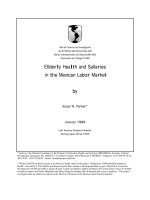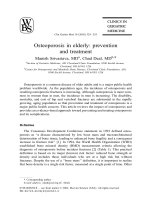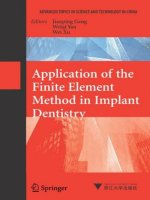UPDATED TOPICS IN MINIMALLY INVASIVE ABDOMINAL SURGERY potx
Bạn đang xem bản rút gọn của tài liệu. Xem và tải ngay bản đầy đủ của tài liệu tại đây (18.34 MB, 256 trang )
UPDATED TOPICS IN
MINIMALLY INVASIVE
ABDOMINAL SURGERY
Edited by Ahmed AbdelRaouf ElGeidie
Updated Topics in Minimally Invasive Abdominal Surgery
Edited by Ahmed AbdelRaouf ElGeidie
Published by InTech
Janeza Trdine 9, 51000 Rijeka, Croatia
Copyright © 2011 InTech
All chapters are Open Access distributed under the Creative Commons Attribution 3.0
license, which permits to copy, distribute, transmit, and adapt the work in any medium,
so long as the original work is properly cited. After this work has been published by
InTech, authors have the right to republish it, in whole or part, in any publication of
which they are the author, and to make other personal use of the work. Any republication,
referencing or personal use of the work must explicitly identify the original source.
As for readers, this license allows users to download, copy and build upon published
chapters even for commercial purposes, as long as the author and publisher are properly
credited, which ensures maximum dissemination and a wider impact of our publications.
Notice
Statements and opinions expressed in the chapters are these of the individual contributors
and not necessarily those of the editors or publisher. No responsibility is accepted for the
accuracy of information contained in the published chapters. The publisher assumes no
responsibility for any damage or injury to persons or property arising out of the use of any
materials, instructions, methods or ideas contained in the book.
Publishing Process Manager Martina Blecic
Technical Editor Teodora Smiljanic
Cover Designer Jan Hyrat
Image Copyright scyther5, 2011. Used under license from Shutterstock.com
First published October, 2011
Printed in Croatia
A free online edition of this book is available at www.intechopen.com
Additional hard copies can be obtained from
Updated Topics in Minimally Invasive Abdominal Surgery,
Edited by Ahmed AbdelRaouf ElGeidie
p. cm.
978-953-307-773-4
free online editions of InTech
Books and Journals can be found at
www.intechopen.com
Contents
Preface IX
Laparoscopic Biliary-Pancreatic Surgery 1
Part 1
Chapter 1 Transcylindrical Cholecystectomy for
the Treatment of Cholelithiasis and Its
Complications Cholecystectomy Under Local Anesthesia 3
E. Javier Grau Talens, Julio Horacio Cattáneo,
Rafael Giraldo Rubio and Pablo Gustavo Mangione Castro
Chapter 2 Laparoscopic Cholecystectomy in High Risk Patients 27
Abdulrahman Saleh Al-Mulhim
Chapter 3 Gallbladder Surgery, Choice of Technique: An Overview 37
E. Nilsson, M. Öman, M.M. Haapamäki and C.B. Sandzén
Chapter 4 Laparoscopy-Assisted Distal Pancreatectomy 53
Masahiko Hirota, Daisuke Hashimoto, Kazuya Sakata, Hideyuki
Kuroki, Youhei Tanaka, Takatoshi Ishiko, Yu Motomura,
Shinji Ishikawa, Yoshitaka Kiyota, Tetsumasa Arita,
Atsushi Inayoshi and Yasushi Yagi
Laparoscopic Liver Surgery 61
Part 2
Chapter 5 Laparoscopic Liver Resection 63
Robert M. Cannon and Joseph F. Buell
Chapter 6 Hilar Glissonean Access in Laparoscopic Liver Resection 77
Akihiro Cho
Chapter 7 Laparoscopic Liver Surgery 87
Steven A. White, Rajesh Y. Satchidanand and Derek M. Manas
Laparoscopic Appendectomy 113
Part 3
Chapter 8 Laparoscopic Appendectomy 115
Konstantinos M. Konstantinidis and Kornilia A. Anastasakou
VI
Contents
Chapter 9 Appendicitis and Appendicectomy 137
Sami M. Shimi
Laparoscopic Hernia Repair Surgery 155
Part 4
Chapter 10 Laparoscopic Hernia Repair 157
Eva Deerenberg, Irene Mulder and Johan Lange
Chapter 11 Laparoscopic Incisional Hernia Repair 181
Anita Kurmann and Guido Beldi
Laparoscopic Solid Organ Surgery 193
Part 5
Chapter 12 Spleen Preserving Surgery and
Related Laparoscopic Techniques 195
Lianxin Liu, Dalong Yin and Hongchi Jiang
Chapter 13 Laparoscopic Gastropexy for the Treatment of
Wandering Spleen With or Without Gastric Volvulus 205
Caroline Francois-Fiquet,Yohann Renard,
Claude Avisse, Hugues Ludot, Mohamed Belouadah
and Marie-Laurence Poli-merol
Miscellaneous Laparoscopic Procedures 223
Part 6
Chapter 14 Laparoscopic Approach to Abdominal Sepsis 225
José Sebastião Santos, Carlos A.M. Donadelli,
Rafael Kemp, Alberto Facury Gaspar and Wilson Salgado Jr.
Chapter 15 Role of Endoscopy in Laparoscopic Procedures 237
Mohamed O. Othman, Mihir Patel and Timothy Woodward
Preface
It goes without saying that the introduction of laparoscopy, with its well-known
advantages, changed the face of surgery. Big surgeons make big incision is now
proved to be incorrect dictum. Now surgeons can work via key holes to reach areas
considered to be very difficult to reach in open surgery. No more ugly big wounds, no
more adhesions, less pain, rapid recovery …. and many more. For all these benefits,
patients ask their surgeons for laparoscopy. However, laparoscopy is not that easy. It
requires new skills and talents that differ from those required in open surgery. It is
more difficult and needs more experience and training.
We tried in this book to present evidence-based up-to-date information in laparoscopic
surgery. This book does not cover all minimally invasive abdominal surgery; only
included selected topics covering a variety of medical conditions. Each chapter is
written by an expert in laparoscopy. The book is geared not only toward surgical
residents in-training, but also to expert surgeons who seek for a recent solution of
some controversies.
I would like to dedicate this book to my wife Reham, my daughter Salma and my son
Omar. Undertaking this book steals time from family, and I very much appreciate
their support.
I believe you will find this book up-to-date and a useful read that could help you in
growing your surgical knowledge about laparoscopy for the sake of your patients.
Ahmed AbdelRaouf ElGeidie
Gastroenterology Surgical Center, Mansoura University,
Egypt
Part 1
Laparoscopic Biliary-Pancreatic Surgery
1
Transcylindrical Cholecystectomy for the
Treatment of Cholelithiasis and Its
Complications: Cholecystectomy
Under Local Anesthesia
E. Javier Grau Talens, Julio Horacio Cattáneo,
Rafael Giraldo Rubio and Pablo Gustavo Mangione Castro
Siberia-Serena Hospital, Talarrubias (Badajoz)
Extremadura University
Spain
1. Introduction
Cholecystectomy is the primary treatment of cholelithiasis. But the prevention of the
formation and the dissolution of the stones were popular in the 80's . The clinical use of the
chenodeoxycholic and after the ursodeoxycholic acid emerged in the 70's, when proved that
this acids reduced biliary cholesterol saturation in bile. Important aspects were significant
but reversible hepatotoxicity in 3%, diarrhea in 8%, abandonment of treatment in 15% and a
similar proportion of abdominal pain. Probably, more important was the increase in total
serum cholesterol and low density lipoprotein during treatment with chenodesoxycholic
acid. In general, ursodeoxycholic acid appears to have fewer side effects, works faster and
causes less liver damage. In patients with small cholesterol stones and floating radiolucent
treated with ursodeoxycholic acid, for 6-12 months, partial or complete dissolution can be
expected in 40-55% of cases.
The direct dissolution of cholesterol gallstones using methyl tert-butyl ether (MBTE)
requires the insertion of a percutaneous transhepatic catheter in the gallbladder. The MBTE
(5-10 mL) should be infused in a manner that involves the calculi but does not flow into the
common bile duct and duodenum. In 4-16 hours the stones are dissolved. The patient
should stay overnight in the hospital. Side effects include pain and nausea; haemolysis and
duodenitis are serious consequences of the spilling of the solvent into the duodenum .
Transabdominal mechanical lithotripsy is another treatment modality, which leads to
fragmentation of the stones in selected cases in almost 100% of patients.
All of these treatments have in common the recurrence of stones (from 45% to 70% at 5 or 7
years of follow-up), due to persistence of a place for the precipitation of cholesterol crystals
(gallbladder) and bile prone to precipitate (lithogenic bile). A report by Gilliland and
Traverso in 1990 settled any doubts about the alternatives in the treatment of cholelithiasis
(Gilliland & Traverso, 1990) These authors reviewed outcomes of 671 cholecystectomy
patients during the years 1982-1987 and found no mortality and 2.2% of complications. They
conclude that open cholecystectomy is a definitive treatment for symptomatic cholelithiasis
with minimal risk to the patient and a high degree of cure of the symptoms.
Updated Topics in Minimally Invasive Abdominal Surgery
4
The first truly major surgery on the biliary tract was performed in 1867 in Indiana (USA).
John S. Bobbs, professor of surgery at the Medical College of Indiana, operates a tumor in
the right upper quadrant in a 30 year old woman, at home and under general anesthesia,
resulting in the diagnosis of gallbladder hydrops which was evacuated and drained. It was
the first cholecystostomy performed in the history.
Fifteen years later, in 1882, Carl J. Langenbush of Berlin performed the first cholecystectomy
by lithiasis, after exercising cholecystectomy in cadavers for several years. However, as
more than a century later would happen with the laparoscopy and in the same Germany,
Langenbush's communication in the German Congress of Surgery of three cases of
cholecystectomy that evolved successfully, was received with apathy and without due
consideration that the time reserved.
1.2 Development of mini-lap (small-incision) cholecystectomy
Minilaparotomy was used for several decades for the diagnosis of obstructive jaundice.
Through a small incision is valued, in addition to the aetiology, the operability by palpation
of the gallbladder and hilum liver and usually the diagnosis included a
cholecistocholangiography.
In 1982 F. Dubois and B. Berthelot (Dubois & Berthelot, 1982) published the first paper on
the minilaparotomy for operations on the bile duct, performing the procedure in 1500
patients, including alongside cholecystectomy, some cases of choledochotomy,
sphincterotomy and choledochoduodenostomy. All these interventions were carried out
with a transverse or oblique skin incision 3 to 6 cm in length, but the duration of surgery,
the authors say, was "twice that of a normal operation". Intervention was carried out with
the help of an autostatic (if no more than one assistant was available), a vaginal valve for
retraction of the liver, a malleable valve for retraction of the hepatic flexure of the colon and
the positioning of two packs for the separation of the colon and stomach, referenced with a
tape.
The description of the intervention with this procedure and its duration arise a suspicion of
some difficulty with exposure of the structures and the easement of the procedure.
However, the authors describe: a minimization of cosmetic damage, solidness of the wall
closure an a reduction of pain and postoperative ileus.
Moss, in 1983, published the first cases of cholecystectomy with stay less than 24 hours, and
in 1986, 100 cases. Later, he operates 160 patients by midline laparotomy, with an incision
that "barely allows the surgeon's hand”, which were discharged the day after surgery
without receiving narcotics, tolerating food intake between 8 and 18 hours and only 3
readmissions. The author concluded in 1996 that the benefits of laparoscopy may be more
related to the enthusiasm and expectations for the new technology that in the technique by
itself (Moss, 1996).
In 1985, Morton (Morton, 1985) performs a cost containment study of cholecystectomy with
intraoperative cholangiography in 96 patients through an incision of 4 to 5 cm with a mean
operating time of 45 minutes. The average stay was 2.5 days and analgesic requirements
were lower than in the classical subcostal incision. The period of sick leave decreased
significantly.
Goco and Chambers in 1988 (Goco & Chambers, 1988) studied the impact of mini-
cholecystectomy in the management of health expenditure, considering the reduction of
hospital costs compared to traditional cholecystectomy. The authors conclude, by analyzing
450 interventions, that a 4-cm incision produces an average stay of 1.22 days and that the
savings stay was 4.78 days per case. Rating the daily cost at $ 200 USA in 1988, it is easy to
Transcylindrical Cholecystectomy for the Treatment
of Cholelithiasis and Its Complications: Cholecystectomy Under Local Anesthesia
5
see the savings produced by minilaparotomy, especially if applied to the 600,000
cholecystectomies performed annually in the United States.
Despite these and further studies, minilaparotomy was never popular. For example, out of
seven standard textbooks: Norton al al., (Harris, 2008). Sabiston (Arendt & Pitt, 2004),
Schwartz (Schwatz 1989), Doherty (Doherty, 2010), Maingot (Karam & Roslyn, 1997),
Marlow & Sherlock (Dawnson, 1985). Morris & Malt (Britton & Bickerstaff, 1994), only the
latter describes the technique of cholecystectomy by minilaparotomy.
1.3 Laparoscopic cholecystectomy – Eric Mühe
Laparoscopy has not only caused a revolution in the treatment of cholelithiasis, but that has
changed an old surgical proverb: "a large incision, a great surgeon." It seems reasonable to
assert that "a smaller incision, less abdominal wall trauma and better aesthetic results." The
era of minimally invasive surgery began and laparoscopy has been extended to almost all
abdominal surgical operation and almost any procedure has been performed by
laparoscopic approach, including resections and all types of gastrointestinal suture.
Interestingly, laparoscopic cholecystectomy was not well received by the German Surgical
Society when E. Mühe reported the first operation in 1986. On September 12, 1985, Mühe
selected with great care the first patient to perform the first laparoscopic cholecystectomy,
almost five years after the first laparoscopic appendectomy by Semm. Like him, Mühe
performed the pneumoperitoneum with the Veress needle, inserted the trocar and
introduced his own "galloscope" through the umbilicus. Two hours later he concluded
successfully the first laparoscopic cholecystectomy (Litynski, 1996). His presentation at the
congress was not published and only a summary appeared in Langenbecks Archiv für
Chirurgie 1986 (Mühe, 1986). However, with subsequent amendments Mühe concluded that
inserting the laparoscope (galloscope) as close as possible to the gallbladder the
"cumbersome" pneumoperitoneum could be avoided. After several cholecystectomies
without gas, trying to simplify and adapt the technique to be used by most surgeons, he
realized that the optical instrument was not necessary, "with or without galloscope, the
magic surgical approach could be the same". Soon operated through sheath of the
galloscope without the optical instrument with the advantages of minimal incision:
- The abdominal musclulature is not cut
- Little postoperative pain that disappears in two or three days
- short Immobilization(even elderly patients need to be in bed only the day of operation)
- Short hospital stay (4-5 days)
- Quick return to work (50-75% earlier than with traditional surgery)
This outlined the bases of minimally invasive surgery. Sadly, Mühe didn´t publish the
evolution of his technique for cholecystectomy in any international journal and we haven´t
hat notice of it until 1996 with the Litynski´s. book.
Many reasons can be considered to explain the success of laparoscopic cholecystectomy:
1. It is obvious that the ports, about 1 cm, scattered in the upper abdomen and a umbilical
opening for the introduction of optic, produce a minimal aesthetic disorder.
2. The trauma to the abdominal wall caused by an incision about 15 cm is large and has a
well-known impact on the respiratory physiology, a greater possibility of formation of
adhesions, hernias and, above all, pain.
3. The acceptance by the patient has been quick, because it was publicized with all of the
above advantages. The charisma of laparoscopic technology is undeniable, its elegance,
too.
Updated Topics in Minimally Invasive Abdominal Surgery
6
4. The commercial pressure has been relentless. Technological research has been
overturned in the design and implementation of increasingly sophisticated and safer
instruments. Sponsoring of the learning of the technique to the interested surgeons was
a strategic objective.
5. Finally, the health financier had an opportunity to reduce hospital stays.
Given all the above mentioned facts it is obvious that the introduction of the technique is an
undeniable fact and that, at present, nobody doubt that laparoscopy is the technique of
choice for cholecystectomy. However, the advantages of laparoscopic cholecystectomy have
been put in evidence, deliberately, with the open cholecystectomy with a generous wound
of about 15 cm. But what if the comparison is made against a technique that uses an incision
of 5 cm or smaller? It is possible that the above mentioned advantages were less obvious
and that the assessment had to be made over other aspects than aesthetics, postoperative
pain, parietal trauma, hospital stay, re-employment, etc., entering the field of cost, security
and benefits to the patient.
2. Laparoscopic vs. small-incision cholecystectomy
A review in 1993 (Olsen, 1993) concluded that there are no good studies comparing
conventional cholecystectomy by minilaparotomy or by laparoscopy. However, it was
apparent that the small incision was better than the big one and that the length of the
incision appears to be associated with hospital stay and return to the workplace. The
ultimate goal is to achieve a safe surgery with the maximum benefit for the patient, and the
keys are: knowledge of anatomy, good surgical view and a proper exposure. This last key to
safety, exposure, is a limiting factor for minilaparotomy, which leads the question of how
small an incision can still provide a exposure to perform the cholecystectomy safely. For
Olsen, the answer is the laparoscopy, which allows for smaller incision, but it is noteworthy
that the sum of the incisones made for the insertion of four trocars is about 4 cm and two-
dimensional view. An incision of this size can provide adequate exposure for
cholecystectomy under direct three-dimensional vision.
An overview of the Cochrane Hepato-Biliary Group reviews in January 2010 (Keus et al.,
2010) revealed the evidence to date of the revisions that assess the effect of differents
techniques of cholecystectomy: open, small-incision, or laparoscopic. A total of 5246 patients
in 56 randomized trials are included. Total complications of laparoscopic cholecystectomy
and small-incision were similar (17%), hospital stay and convalescence were not
significantly different, small-incision cholecystectomy operative time was shortest (16.4
minutes) and is less costly. In our study of 1998 (Grau-Talens et al., 1998) small-incision
cholecystectomy was $ 1003 U.S less costly than laparoscopic. The effects of anesthesia and
surgery on lung function have been well studied (Lindell & Hendenstierna 1976). There is a
reduction in FVC (Forced Vital Capacity) and FEV1 (Forced Expiratory Volume in one
second) to 75% of baseline for a separate incision without cutting the muscles, while
reducing down to 40-55% in the subcostal incisions and midline laparotomy. An incision
that spares the muscular section can prevent postoperative pulmonary complications. The
restrictive pattern of lung dysfunction in postoperative abdominal surgery is influenced by
several factors and is not well understood. The size, location and direction of the incision are
responsible for the alteration of mechanical ventilation, by themselves and the pain. Kind of
anesthetic agent and diaphragmatic dysfunction are also involved (Craig 1981).
Transcylindrical Cholecystectomy for the Treatment
of Cholelithiasis and Its Complications: Cholecystectomy Under Local Anesthesia
7
In some studies, laparoscopic cholecystectomy has shown lower spirometric reductions
when compared to open cholecystectomy (Frazee et al., 1991) and to mini-lap (McMahon et
al., 1994) although the latter with incisions between 5 and 10 cm. Presumably, a reduction in
the length of the incision could be rewarded by a smaller reduction in the impairment of
lung physiology, ie, an incision of 4.5 cm, uniform to all layers of the abdominal wall could
improve postoperative spirometric results as happened in our study (Grau-Talens et
al.,1998) wich shows that the reduction of spirometrics values were similar in laparoscopic
and small-incision cholecystectomy, ie over 20% of preoperative value for FVC and 25% for
FEV1. The results obtained by keus et al. are similar to ours (Keus et al 2008).
3. Treatment options in biliary lithiasis complications
3.1 Acute cholecystitis
Early cholecystectomy is the best treatement for acute cholecystitis. Laparoscopic
cholecystectomy was a relative contraindication in acute cholecystitis, but now is the
preferred aproach for most patients. The first articles appear in the early 90´s (Cooperman,
1990) (Yamashita et al., 2007). However, in our experience, cholecystectomy in this way was
not easy: the difficulties are related to the inflammatory process, with greater difficulty for
dissection and recognition of structures, the possibility of further contamination of the
cavity (not the surgical wound), the need for instruments to 10 mm in diameter, greater
difficulty in haemostasis and, of course, a greater proportion of conversions (35%) and
duration of the intervention.
With these preliminary considerations we began to operate the acute cholecystitis by early
transcylindrical cholecystectomy (within 72 hours or more of admission), thinking that the
abdominal wall injury should not be higher than laparoscopy, even using the cylinder of 5
cm in diameter, that manipulation of the gallbladder (gripping, aspiration, recovery of
stones etc.) could be done in a simpler way than by laparoscopy, and that contamination of
the surgical wound could be avoided by the protective and insulating effect of the cylinder.
We have only found an article of acute cholecystitis treated by minilaparotomy in the
context of a randomized study comparing minilaparotomy with conventional laparotomy
(Assalia et al., 1997). The authors show figures contrasting results in a very favourable way,
not only with traditional laparotomy, but with the laparoscopic approach. In this article the
average time (+ /-SD) of the intervention was 69.1 (+ / - 17.0) minutes and mean hospital
stay was 3.1 days.
3.2 Choledocholithiasis
The choledochotomy was first performed in 1884 by Kummel and in 1889 by Thornton and
Abbe, who made the first ideal suture of the choledochotomy. In the late nineteenth and
early twentieth century the common bile duct exploration was guided by the subjective
clinical impression of the surgeon, until the introduction of intraoperative cholangiography
by Mirizzi in 1937. In the Massachusetts General Hospital (Bartlett & Waddell, 1958) were
reviewed 1000 choledochotomy for suspected choledocholithiasis with a mortality of 1.8%
(three times higher than simple cholecystectomy) and 16% global choledocholithiasis. In the
presence of previous pancreatitis, stones were found at choledochotomy in 12% of the
patients; in the presence of jaundice or a reliable history of jaundice, 35%; in the previous
situation more palpable stone in 99%; with bile duct larger than 1 cm diameter, 58%;
Updated Topics in Minimally Invasive Abdominal Surgery
8
jaundice and only cystic dilated (greater than 4 mm), 50%; when occurred only jaundice and
small stones (<0.5 cm) in 34%. In patients without jaundice, the presence of stones in the
choledochotomy was as follows: If calculation palpable, 89%; if dilated common bile duct,
53%; if the cystic duct dilated, 29%; and in the presence of small stones, 16%.
With the arrival of cholangiography the negative common bile duct exploration decreased
from 50% to 6%, the incidence of retained stones also fell from 25% to 11%. Moreover,
although it was not popular until the 70, the introduction of rigid choledochoscope in 1941
by McIver reduced the incidence of retained stones. A big progress in the treatment of
retained stones was the introduction of endoscopic sphincterotomy in 1974 by german and
japanese authors (Classen &Demling, 1974) with a success rate of 95%, 15% morbidity and
mortality from 0.2 to 1.5% ( Escorrou et al., 1984), relativized the problem of retained stones
and its treatment and compared favourably with surgical sphincterotomy, whose mortality
was 2.9 to 4.4%.
With the introduction of laparoscopic cholecystectomy, surgery for gallstones changed and
preoperative endoscopic retrograde cholangiography became the rule in the care of patients
suspected of gallstones in the bile duct to avoid open choledochotomy. In experienced
centres, the success rate of ERCP in the extraction of common duct stones is 90% but 1%
overall mortality and complication rate of 6% to 10% (Fink, 1993). The risk of mortality and
morbidity should be added to the subsequent laparoscopic cholecystectomy. If we accept a
risk of death of 0.3% and 5% complication rate for laparoscopic cholecystectomy, the overall
mortality of the sum of the two procedures can be 1.3% and morbidity of 11 to 15% (Tomkin,
1997).
Other notable aspects of this sequence of treatments (first ERCP and posterior
cholecystectomy) are: the cost and the negative ERCP, ie, discriminating which patients
have choledocholithiasis preoperatively. A study by Koo and Traverso (Koo &Traverso,
1996) revealed that the history is the best predictor of choledocholithiasis, but was only able
to predict 45% of cases, surpassing the biochemistry of liver function and ultrasound. For
this reason, preoperative ERCP is rewarded with the discovery of choledocholithiasis in no
more than 50% of cases, which are obviously exposed to morbidity and mortality, and raise
the cost of surgical practice. In another recent study, ERCP was performed only if the
patient had any of the following criteria: dilatation of the bile duct by ultrasound, gallstone
pancreatitis or abnormalities of liver function tests (Katz et al., 2004). ERCP was performed
in 41 patients and stones were found in 22 (53.7%). The authors conclude that dilatation of
the bile duct along with liver function abnormalities are the most useful, with a yield of 82%
correct in detecting choledocholithiasis.
In the last decade has improved radiological assessment of patients with suspected common
bile duct stones. Transabdominal ultrasounds are not very sensitive in detecting common
bile duct stones, but if ultrasounds are negative and liver function is normal, the chances of
choledocholithiasis are minimal. Magnetic resonance cholangiopancreatograpy and
endoscopic ultrasonography have high sensitivity and specificity (grater than 90%) and are
the best options as preoperative assessment (Werbesey & Birkett 2008). There are different
diagnostic and therapeutic options to address the common bile duct, but not an algorithm
that can be considered the standard criterion. The management of this disease depends on
the experience and the possibilities of available technology of each working group. The
therapeutic approaches are:
- Preoperative ERCP and later laparoscopic cholecystectomy
- Laparoscopic surgery and rendezvous
Transcylindrical Cholecystectomy for the Treatment
of Cholelithiasis and Its Complications: Cholecystectomy Under Local Anesthesia
9
- Laparoscopic cholecystectomy and, if necessary, laparoscopic common bile duct
exploration
- Transcylindrical cholecystectomy and, if necessary, transcylindrical common bile duct
exploration
- Conventional open surgery
- Laparoscopic cholecystectomy more postoperative ERCP
The first option does not seem reasonable for the reasons already discussed, the last remains
reserved for the failures of laparoscopic choledochotomy and retained stones. Conventional
open surgery may remain as an option, but at the much higher wall trauma, the greater
number of stays, the worse aesthetic outcome and greater disability after surgery. A
randomized study demonstrated a greater benefit for the treatment of choledocholithiasis
with laparoscopic common bile duct exploration than with postoperative ERCP (Rhodes et
al., 1998).
Laparoscopic exploration of common bile duct has been developed in the 90's, almost
simultaneously with laparoscopic cholecystectomy, and is performed through the cystic
duct or choledochotomy. Laparoscopic choledochotomy is technically demanding, is a
difficult procedure that requires a great deal of laparoscopic skill (Kroh & Chand, 2008). In
this sense, a simple technique, as is the transcylindrical approach, can have a place in the
common bile duct exploration.
In our Hospital this is the algorithm for suspected choledocholithiasis:
4. Transcylindrical cholecystectomy
In 1992, we started laparoscopic cholecystectomy in the Hospital Verge del Toro (Mahon,
Menorca, Spain) after a training period at another hospital. The technique quickly settled in
the hospital, in a time of full discussion of the validity of this approach and the need for
prior training. We conducted a series of 11 laparoscopic cholecystectomy, until the absence
of capnography and other circumstances prevented continuation of the procedure The
laparoscopic view of Calot's triangle, with the camera close enough to the structures, as it’s
Updated Topics in Minimally Invasive Abdominal Surgery
10
set to perform the dissection, does not focus more than a few square centimetres area, which
is where the dissections and sections between clips of the cystic duct and cystic artery are
performed. It crossed our minds that this limited field, but sufficient for the laparoscopic
dissection, could be constructed in a straightforward manner, without camera, with a
cylindrical or tubular separator that prevented the interposition of intraperitoneal mobile
structures between the surgeon's eyes and structures hepatocystic triangle. Of course, the
dissection should be performed through the cylinder with material that could be used in
laparoscopic or open surgery. With these premises we entrust the construction of the first
steel cylinder, 5 cm in diameter and 10 in length, with a polypropylene plunger, like a
piston, which protruded from the distal end, with the purpose of helping to introduce and
reject the intraperitoneal mobile structures, which could interpose and hinder the
hepatocystic triangle. The first time we use it (August 1993) we were rewarded with the
success of an intervention without mishap. With the cylinder of 5 cm in diameter were
obtained an incision 6-7 cm in length, which could be reduced by a smaller diameter
cylinder, therefore, we inquired the construction of another cylinder, 3.8 cm in diameter and
with the same length. The choice of length is based on measurements made in emergency
surgery, from skin to the triangle hepatocystic. Cholecystectomy with the new cylinder was
still easy, but with an incision 4.5 cm length uniform in all the layers of the abdominal wall,
aesthetics and a smooth postoperative period where they drew more attention to nausea
and vomits than pain. Hepatocystic triangle dissection and recognition of the structures left
us less uncertainty than in the laparoscopic approach, we could ensure the identity of the
structures and fingertip exploration of the consistency of the organs. We considered it a safe,
as it allowed the steps of the classical open cholecystectomy. We decided to call the
technique transcylindrical cholecystectomy. The first communication in a conference dates back
to 1994 when we presented a video communication with the first 20 cases in "The X Surgical
Day of District Hospitals” (Tarragona, May 6, 1994). That same year it was admitted to the
"XX National Congress of Surgery of the Surgical Spanish Association" Madrid, November,
1994 (Grau-Talens et al., 1994).
The review of the literature on minilaparotomy cholecystectomy and the method used by
the authors showed no results of a technique similar to ours, although other types of
separators or optical instruments have been developed (O´Dwyer et al.,1990), (O´Kelly et al.,
1991) (Rozsos et al.,2003) (Russell & Shankar, 1987) (Shumacher & Kohaus 1994). Rozsos et
al., 1997 distinguish between: microlaparotomy, where the incision is less than 4 cm in
length, modern minilaparotomy, where it comes to 4-6 cm incision and classical
minilaparotomy, with 6-8 cm.
The first operation of transcylindrical cholecystectomy under local anesthesia and
sedation dates to 1996, in a patient with low body mass index and followed by other cases
performed sporadically. The experience accumulated over 15 years and 387 interventions
(Grau-Talens & Giner, 2010) showed us the safety and applicability of transcylindrical
cholecystectomy and was applied to realization of the technique in outpatient surgery in
the Hospital Siberia-Serena (Talarrubias, Badajoz, Spain), where we offer the
transcylindrical cholecystectomy under local anesthesia and sedation to all patients with
almost no exceptions (Grau-Talens et al., 2010). Patients greatly appreciate the possibility
of not being entirely deprived of consciousness and not to be connected to a respirator
during cholecystectomy perhaps resulting in a reduction of preoperative anxiety and
stress.
Transcylindrical Cholecystectomy for the Treatment
of Cholelithiasis and Its Complications: Cholecystectomy Under Local Anesthesia
11
4.1 Selection of patients for transcyndrical cholecystectomy in hospitalization and
day-case surgery under local anesthesia plus sedation
Between 1993 and 2008 the patients with symptomatic cholelithiasis, recovering from
mild/moderate acute biliary pancreatitis or acute cholecystitis were treated by
transcylindrical cholecystectomy. Since 1996 we treat choledocholithiasis in this way.
Informed consent was requested for each patient explaining both the novelty of the
transcylindrical cholecystectomy and its rationality, like a minilaparotomy, for aesthetic and
functional benefits of a small incision, in order to prevent biliary colic and complications of
lithiasis (acute cholecystitis, pancreatitis or recurrent pancreatitis and gallbladder cancer),
with emphasis on uncertainty about other symptoms such as headache, dyspepsia, bitter
taste, abdominal pain not related to gallstones and food intolerance. All possible and
reasonable complications are listed in the informed consent of the Asociación Española de
Cirujanos (Spanish Association of Surgeons), the patient read and sign before being
included in the surgical waiting list.
With the exception of a randomized study period for comparison with laparoscopic
cholecystectomy this series of cases should be considered consecutive. In this way, 387
patients have been included in the study.
Although the 3.8 cm cylinder has been used in most cases, the 5 cm cylinder was used,
primarily, in the following situations: diagnosis of acute cholecystitis, strong suspicion of
choledocholithiasis (medical history jaundice, common bile duct dilatation greater than 12
mm) and when doubt exists in the identification of structures of the hepatocystic triangle
with the cylinder of 3.8 cm. This was used in light of the diagnosis of biliary colic, regardless
of the ultrasound findings (normal gallbladder or sclerotic) and in patients recovering from
acute pancreatitis. Intraoperative cholangiography was performed selectively.
From 2008 to the present day we exercise our practice in the Hospital Siberia-Serena
(Badajoz, Spain), a public community hospital with short-stay and ambulatory surgical
facilities. All of our patients are referred to us for elective surgery. The surgical emergencies
are translated to de District General Hospital in the area, nevertheless, we accept
hospitalized patients with complications of biliary lithiasis and are operated as a as soon as
possible. Include patients with cholelithiasis, acute cholecystitis, acute pancreatitis before
discharge and choledocholithiasis. We have 4 beds for patients who require hospitalization
for short stay surgery.
Patients scheduled for day-case surgery must meet the general criteria of suitable personal
and familiar environment and distance from the centre of not more than 45 minutes,
together with the ASA I-III.
The selection of patients who would undergo transcylindrical cholecystectomy under local
anesthesia plus sedation was done under the following assumptions:
1. Acceptance by the patient to undergo the procedure under local anaesthesia, and the
possibility that it will be converted to general anaesthesia if necessary
2. Assessment by the surgeon that the patient meets the general requirements to be
involved in ambulatory surgery
3. The assessment by the anaesthesiologist in charge of the case, the degree of patient
anxiety, which might conspire with the necessary cooperation of the latter in the case of
sedation and local anaesthesia, in addition to the usual pre-anaesthetic evaluation.
4.2 The cylinders
Initially we have designed and constructed a stainless steel cylinder with a polypropylene
perforated plunger, like a piston, which protrudes from one end. It is 10 cm long and 3.8 cm
Updated Topics in Minimally Invasive Abdominal Surgery
12
in diameter providing a surgical field area of 11.33 cm2, and another which is 10 cm long but
5 cm in diameter providing to surgical field area of 19.62 cm2 . These sizes have been based
on the distance between the wall and the hepatocystic triangle, measured in open surgery,
and the minimally area necessary for the identification and dissection of its structures.
We currently use a transparent methacrylate plunger that there exercises an effect of
magnifying glass and once introduced into the abdomen allows visualization of the surgical
field before unplugging (figure 1).
Fig. 1. Cylinders used in Transcylindrical cholecystectomy
The cylinder commonly used is made of stainless steel, though we occasionally use a
cylinder totally made in methacrylate to facilitate intraoperative cholangiography. The size
of cylinders is always 10.0 cm long and either 3.8 or 5 cm in diameter. But we have cylinders
12 and 14 cm in length, rarely needed in the bigest patients or abnormal liver depth under
Transcylindrical Cholecystectomy for the Treatment
of Cholelithiasis and Its Complications: Cholecystectomy Under Local Anesthesia
13
the ribs in the subdiaphragmatic space. In young people, the use of a cylinder of 2.8 cm in
diameter produces an almost imperceptible scar (Figure 2, 3).
Fig. 2. Methacrylate cylinder, 2,8 cm in diameter
4.3 Technique and equipment
To introduce the 3.8-cm cylinder one makes a right transversal-epigastric incision of 4.5 cm
two fingerbreath lateral to the midline, approximately at the seventh or eighth
costochondral cartilages level. One then proceeds with a longitudinal incision of the rectus
sheath, splitting the muscle and cutting the posterior leaf and peritoneum. This is an
uniform 4.5 cm section of all the abdominal wall layers. A suture of polypropylene (No. 1) is
then passed through the whole thickness of the wall (not including the skin) on both side of
the incision, which helps to guide the introduction of the cylinder. We make sure that there
is nothing adhering and check the normality of neighbouring organs by two finger
exploration.
Once it is past the surface of the skin it is softly slided and enters without difficulty to its full
extent towards the hepatocystic triangle. While we are inserting the cylinder we are seeing
the intraperitoneal structures through the transparent plunger, especially the white
appearance of the anteromedial aspect of the gallbladder and Hartmann's pouch and we can
see, with a little pressure , the cystic duct and common bile duct (Figures 4, 5). Any
gallbladder adherence to the hepatic flexure of the colon or omentum can be freed.
Updated Topics in Minimally Invasive Abdominal Surgery
14
Fig. 3. Incision of 3,5 cm in length
Fig. 4. Cylinder bottom through the methacrylate plug
Transcylindrical Cholecystectomy for the Treatment
of Cholelithiasis and Its Complications: Cholecystectomy Under Local Anesthesia
15
Before reaching a working position of the cylinder, this is gently moved inside of the
abdomen. The blunt shape of the plunger end, slightly protruding from the intra-abdominal
side of the cylinder, facilitates this movement. The plunger can be withdrawn and
reintroduced as many times as necessary to identify anatomical structures. Lamp lights
usually suffice to illuminate the operative field, but a cold light may be of help occasionally.
Fig. 5. View of the hepatocystic triangle through the plug
Part of the gallbladder with its infundubulum is visible at the bottom of the cylinder, as well
as the omentum, duodenal bulb or colon. The infundibulum or Hartmann Pouch is grasped
with tissue Foerster forceps and is drawn anterior and laterally and a medium swab inside
the cylinder is used to displace the organs that impede the sight of the angle between the
gallbladder and the hepatoduodenal ligament. Afterwards the hepatocystic triangle is
dissected using conventional material (Figure 6).
The peritoneum is incised on the hepatocystic triangle, close to the gallbladder neck, and the
fat is carefully dissected away on the free edge of the angle between the infundibulum and
the hepatoduodenal ligament using gauze pledget held in an other Foerster forceps, until
the cystic duct (Figure 7) and common bile duct are clearly defined (no always this later).
Afterwards, we check that the cystic duct follows clearly from the gallbladder neck. If the
cystic duct lymph node and cystic artery are not yet visible, the dissection is done gently
upwards to discover the cystic artery, which will be followed up to its entrance into the









